- Home
- Rudy Rucker
The Hacker and the Ants
The Hacker and the Ants Read online
Table of Contents
Books by Rudy Rucker
Title Page
Dedication
Preface
ONE - The Dark Dream
TWO - Gretchen
THREE - The Antland of Fnoor
FOUR - WEST WEST
FIVE - The Vo Family
SIX - Treason ?
SEVEN - Bloodlust Hacking Frenzy
EIGHT - Riscky Pharbeque
NINE - Y9707
TEN - Hi, Roger
ELEVEN - The Battle
TWELVE - Reboot
Copyright Page
Books by Rudy Rucker
Software Engineering and Computer Games
Spaceland
As Above, So Below: A Novel of Peter Bruegel
Gnarl! (Four Walls Eight Windows, 2000)
Realware
Saucer Wisdom
Seek! (Four Wall Eight Windows, 1999)
Freeware
The Hacker and the Ants (Four Walls Eight
Windows, 2002)
Transreal!
The Hollow Earth
All The Visions
Wetware
Mind Tools
The Secret of Life
Master of Space and Time
The Fourth Dimension
The Sex Sphere
The Fifty-Seventh Franz Kafka
Software
Infinity and the Mind
White Light (Four Walls Eight Windows, 2001)
Spacetime Donuts
Geometry, Relativity and the Fourth Dimension
For Marianne von Bitter Rucker August 22, 1916—July 14, 1991
Nobility and love: she never compromised.
Preface for The Hacker and the Ants, Release 2.0
I finished the first version of The Hacker and the Ants in early 1993. At that time I’d recently been laid off after three pleasant years of work at the computer software company Autodesk, Inc.
It’s worth mentioning that in Silicon Valley, the word “hacker” is often still used in its original sense of “a fanatically dedicated and inventive programmer” rather than the modern, corrupted sense of “a computer criminal.” The protagonist of The Hacker and the Ants is mostly the former, with only a touch of the latter.
The “ants” of the title were inspired by a program called boppers.exe which I wrote for Autodesk. The program was designed to demonstrate the principles of artificial life, and is now available for free download from www.rudyrucker.com. The program shows artificial ant critters which evolve and get better at their tasks. What kinds of tasks? In one of the program’s settings, the red ants try to bump into the green ants’ trails and avoid the blue ants’ trails. Not quite like designing industrial robots, but it’s a start.
True to the tinkering hacker spirit, I’ve freely revised The Hacker and the Ants for its republication by Four Walls Eight Windows. It seems reasonable to refer to this edition as “Release 2.0.”
One change was to remove any anachronisms that might have made the book seem twentieth rather than twenty-first century. Given that the basic ideas of the book are futuristic, I wanted to at least keep it contemporary.
A second change was to clarify the descriptions of how to evolve better robots. In doing this, I drew on some useful suggestions made by my friend John Walker. I did not, however, use all of John’s ideas; when you’ve finished reading The Hacker and the Ants, you might enjoy looking at his alternate ending for the book posted on his website www.fourmilab.ch.
A third group of changes had to do with making Jerzy Rugby a more pleasant person and giving him a more coherent emotional life. But don’t hope for too much in the way of self-awareness—Jerzy’s still just a hacker.
A final change was to add a sentence indicating the path by which the robots of The Hacker and the Ants lead to the robots of my novel Software.
It’s a special pleasure to have this new edition out with a cover by my daughter, Georgia Rucker, of www.pinkdesigninc.com. Many thanks to John Oakes of Four Walls Eight Windows for his support.
Rudy Rucker
Los Gatos. California
August 18, 2002
ONE
The Dark Dream
MONDAY MORNING WHEN I ANSWERED THE door there were twenty-one new real estate agents there, all in horrible polyester gold jackets. They came swarming in and scattered to every corner of my great dry-rotted California manse. Several of them had video cameras. What a thing to wake up to.
I’d been tenaciously renting the place for two and a half years despite the fact that the Indiana owner (a Mr. Nutt) continuously had it up for sale. I tried to make it hard for people to get in to look at the house, and even if an agent did manage to bring a client inside, the place had enough flaws (termites, bad foundation, bad plumbing) that nobody had wanted to buy it yet.
Sooner or later, each agent gave up, but then before long a new Realtor would stumble over the listing and come bustling in, eager to make a fat commission—perhaps as much as forty thousand dollars—by moving me out. The one here today was a frozen-faced five-foot-four yuppie blond. She’d been here before. Her name was Susan Poker and she was blandly bent on making my life so miserable that I would move out to make her activities easier.
“I appreciate your working with us on this, Mr. Rugby,” she told me after herding her twenty-one agents in through my door. She wore a dark blue skirt, a frilly white blouse and, as a mark of rank, no gold blazer. She had a gold watch and small but heavy gold earrings. She stood on my front stoop, her sunglasses impenetrable in the bright April sun, her face a mask of peach and tan makeup with thin, bright red lips. She showed her joined teeth as a gesture for a smile.
If I describe Susan Poker so particularly, it does not mean that I found her attractive. My emotions toward her were the opposite of love at first sight. This feeling for Susan Poker was of such intensity that had it been love, I would have proposed to marry her. But as things truly stood, it was my fervent wish never to see her again or, failing that, to crush her like a bug.
Actually, I’d been feeling that way about lots of people lately. My wife Carol had left me two months ago, the bitch, and I was having trouble adjusting to life alone. One of our teenagers was at college, and the other two had gone with Carol, who was living with her boyfriend in a cheesy condo on the east side of the Valley. She had a job teaching English as a Second Language to Latinos and Vietnamese. I’d kept the big house so the kids could still have their own rooms here when they visited or stopped by after school, but this weekend the two highschoolers had stayed with Carol, the brats. Being all alone, I’d hacked all day every day as usual. Sleep was the only slack I ever had, and Susan Poker had woken me up too early.
“Why did you bring so many agents?” said I, essaying a tone of testy befuddlement. “And why do they have cameras?” My personal robot Studly sidled up behind me to peer out at Susan Poker, and then whipped around to tag after our unwanted guests.
“Some of them are new,” said Susan Poker. “We’re using your property for training today. It could set off some networking. The property’s been so terribly slow to move . . . I think heroic measures are called for. And the videocams? We want to get a data base so we can give browsers a virtual walk-through to decide if they want to view.” Her well-shod foot tappity-tapped the metal lockbox that she’d recently bolted to the outside of my house, down on the ground next to my front door. “With the key in here, agents will be able to come and go when you’re not home. We’ll be as little bother to you as possible.” She rummaged in her double-jointed beige leather purse and drew out a gold stylus and a digital assistant. “What are your work hours? I want to put some times in the listing; times when you’ll be out of the house.” She
poised her stylus and glanced up at me. “Another thought. If I can get it cleared with the branch office, I want to set up an Open House for as many Saturdays and Sundays of this month as you and I can handle.” She scrunched her nose to indicate pluckiness.
“That’s impossible!” I exclaimed. “It’s all impossible. I work at home; I never leave. And I don’t want Realtors letting themselves in. And as for an Open House . . .”
“Looky out back, Donny,” yelled one of the novice Realtors, a lean bumpkin with a Western accent. “Thar’s a crick!” Far from a creek, it was a dry gully. This overlaying of idiotic errors onto my own perceptual space was insufferable.
“I have a rental contract!” I shouted at Susan Poker. “If someone wants to come in here, they have to call me twenty-four hours in advance, and set up an appointment. It’s in my contract! No exceptions!”
“Mr. Rugby, I’m friends with a young couple who are looking for a place to rent. If you’re unwilling to cooperate, I’m sure I can move them in here.” She turned huffily and strode to her idling Mercedes diesel, there theatrically to pick up her cellular phone. The really killing thing about this performance was that Susan Poker had not yet even talked to Mr. Nutt, the home’s owner. She was a plastic-faced scavenger with no moral authority to harass me.
The voices and footsteps of the twenty-one new agents went on and on. Several of them handed me cards, gave encouraging winks, or tried to start conversations. Though but larvae and pupae of the species Realtor, they were frighteningly reminiscent of the adult vermin. Several of them commented on Studly the personal robot, marveling at his ability to follow them up and down my stairs. They’d never seen anything like Studly before, and no wonder, as he was an experimental prototype for a product that had yet to reach the market.
Finally the front door slammed and it was over, though two raggedly linked knots of Realtors lingered outside, chatting. I went and dead-bolted the doors, lest. one of the agents gets the house key from the lockbox and comes back in.
I headed back toward my computer, located in the sun porch off the rear master bedroom. Time to hack some more.
My current job was with GoMotion Incorporated of Santa Clara, California. GoMotion got its start selling kits for a self-guiding dune buggy called the Iron Camel. The kit was a computer software CD that was like an interactive three-dimensional blueprint along with assembly instructions. GoMotion kit software used electronic mail to order all the parts you’d need, and it guided you step-by-step through the assembly, calling in registered building helpers if you needed them. Once you got the thing built, our kit would load intelligent software into the vehicle’s processor board, and you’d have a dune buggy that could drive itself. Various models of the Iron Camel had sold one and a half million units worldwide!
GoMotion had hired me a year earlier to help develop a new product: a kit and software for a customized personal robot called the Veep. The preliminary design work was all being done in virtual reality; instead of building lots of expensive prototype machines, GoMotion liked to put together computer models of machines that could be tested out inside cyberspace.
My contribution to the Veep project was to use artificial life techniques as a means of evolving better algorithms for the Veep. The idea behind artificial life was to create a lot of different versions of a program and to let the versions compete, mutate, and reproduce until eventually a winner emerged. In certain situations—like figuring out the best way to set a thousand nonlinearly coupled numerical parameters—a-life was the best way to go, although not everyone in the business believed this. I owed my job at GoMotion to the fact that Roger Coolidge, the superhacker founder of the company, was a vigorous a-life enthusiast, actively engaged in a series of experiments with electronic ant farms.
A linguistic note here. Among intensely geeked-out people like Roger and me, the word “hacker” has always meant “fanatically committed programmer,” and not, as the uninitiated sometimes use it, “computer criminal.” The confusion has to do with the media’s inability to distinguish between the majesty of programming an intelligent robot as opposed to the cheap legerdemain of stealing a porn-dog’s credit card number. We true hackers prefer to use the words “phreak” or “cryp” for the those who jam and sample instead of creating original code. But, in terms of popular usage, we’re fighting an uphill battle and, yes, sometimes the distinction really isn’t so clear.
The robot Studly was the first physical prototype of a Veep that GoMotion had actually built. Studly was a joy to behold, a heartwarming payoff for all the mind-numbing hacking that went into making him happen. He moved around on single-jointed legs which ended in off-the-shelf stunt-bicycle wheels. There were small idler wheels on the knees of these legs, so that on smooth surfaces Studly could kneel down and nestle his body in between his big wheels, with the little knee wheels rolling on ahead. In this mode, he didn’t have to waste compute time keeping his balance. Out in the yard, Studly would rise up into a bent-knee crouch, using arm motions and internal gyroscopes to steady himself. On stairs, the full glory of Studly’s a-life—evolved control algorithms came into play; he would turn sideways and work his way up or down with his two wheels on different steps, using precise lunges and gyro pulses to keep from falling over. Depending on your mood, Studly’s peculiar movements seemed comic, beautiful, or obscurely sinister.
As I sat down at my desk, I had a sudden vision of “giving” Studly to Susan Poker after programming him to chop her up and push her down her garbage disposal. The blood would be on Studly’s manipulators, not mine. I tunelessly hummed the way I do when I think thoughts I shouldn’t.
The phone rang.
“Hello, Mr. Rugby?” A woman’s brisk, aggressive voice.
“Yes.”
“This is Louise Calder from Welsh & Tayke Realty. Do you mind if I bring a client by in half an hour? They’re quite interested in the property.”
“I’m very busy today. I don’t want to show the house.”
The voice was instantly, unforgivingly venomous. “I’ll pass that on to the owner, Mr. Rugby. Good-bye.” She hung up and immediately the phone began to ring again. Friends of Susan Poker. While the phone rang on, I donned the headset and control gloves of my computer. The headset showed me the image of an office with a ringing telephone. I had a computer-generated body image in this virtual office, and the body moved around with the gestures of my control gloves. I flew across the office and pulled the virtual wires out of my virtual telephone. The ringing stopped.
My computer system was configured as a cyberdeck, complete with two gray Spandex control gloves and a white plastic headset, all connected to the computer by wires. The system was almost top of the line, but not quite. If GoMotion had been willing to spend just a little more, my gloves and headset would have had wireless computer connections, so that I could move around more while using them.
But anyway. My computer generated three-dimensional graphics that it showed from any angle, in stereo vision, feeding pairs of images to the two electronic lenses of my headset. The headset had a microphone and speakers, also a sensor that told the system about my head movements so it could update the viewpoint.
The system let me feel as if I were inside a different space, the artificial reality of the computer. Most people called it cyberspace. Turning or moving my head would change my viewpoint; I could lean to one side and look around a nearby object. And the gloves let the computer generate real-time images of my hands. Seeing moving images of my hands in front of me enhanced the illusion that I was really inside cyberspace.
The simulated objects of cyberspace were known as simmies. My hand images were simmies, as was the virtual phone in my cyberspace office. As well as having a characteristic appearance, a simmie had a characteristic behavior—one simmie might sit still, and another might like to move around. The behavior part of a simmie could become so complicated that the thing practically seemed alive.
In cyberspace I could wrap my fingers around th
e simmies I found, effectively grabbing hold of them. And once I had hold of a simmie, I could move it about—unless the simmie happened to insist on staying in one place. When I would point and nod, my viewpoint would start moving in the direction I was pointing in. I would make a fist to stop.
But what was cyberspace? Where did it come from? Cyberspace had oozed out of the world’s computers like stage-magic fog. Cyberspace was an alternate reality, it was the huge interconnected computation that was being collectively run by planet Earth’s computers around the clock. Cyberspace was the information Net, but more than the Net, cyberspace was a shared vision of the Net as a physical space.
My illusion of being able to step right into cyberspace was made convincing by my headset’s most excellent electronic lenses. The lenses were lumps of optical glass with funky-looking patches of plastic glued to them. The patches were rhodopsin-doped limpware goodies that worked as endlessly tweakable color monitors, labile as the chromatophores of a squid. The lenses’ glass bent way around on the sides, creating peripheral vision and eyeball kicks from the anamorphic edge-scrunched images my computer made.
Whenever I put on the gloves and the headset, it was like being in a different room, an invisible secret room of my house: my virtual office. When I talked or made gestures in my virtual office, my computer interpreted me and executed my commands. The “pulling wires out of the phone” gesture for instance, caused my computer to shunt all my incoming phone calls to an answering machine.
My virtual office could look like almost anything—it could be a palace, an igloo, or a bubble in the deep blue sea. As it happened, I was using the default office pattern which came with my cyberspace software. The default office was really two-thirds of an office: it had one wall missing and no ceiling. One of the remaining walls was for doors to Net locations I often visited, and the other two walls were covered with pictures and documents that I either liked or needed to remember. Over my walls and in the far background I would see whatever landscape I was currently hottest for—in those days it was a swamp with simmies that looked like dinosaurs and pterodactyls. It was called Roarworld; I’d gotten it off the Net.

 Million Mile Road Trip
Million Mile Road Trip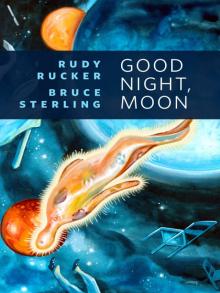 Good Night, Moon
Good Night, Moon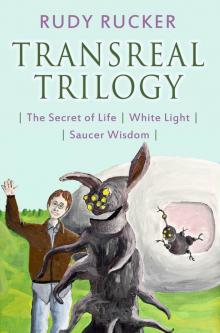 Transreal Trilogy: Secret of Life, White Light, Saucer Wisdom
Transreal Trilogy: Secret of Life, White Light, Saucer Wisdom Complete Stories
Complete Stories The Sex Sphere
The Sex Sphere Surfing the Gnarl
Surfing the Gnarl Software
Software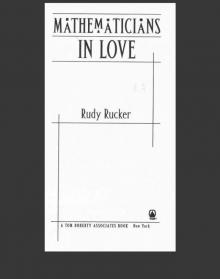 Mathematicians in Love
Mathematicians in Love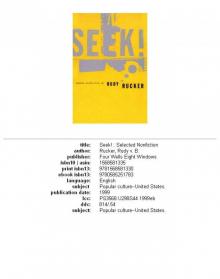 Seek!: Selected Nonfiction
Seek!: Selected Nonfiction The Secret of Life
The Secret of Life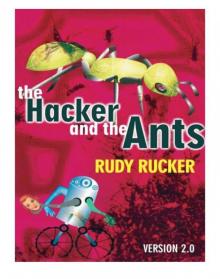 The Hacker and the Ants
The Hacker and the Ants Postsingular
Postsingular Spaceland
Spaceland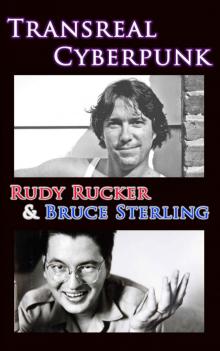 Transreal Cyberpunk
Transreal Cyberpunk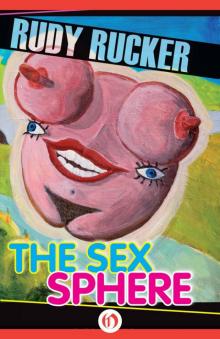 Sex Sphere
Sex Sphere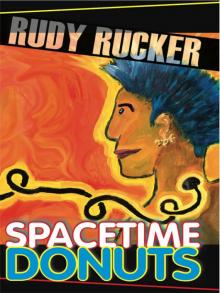 Spacetime Donuts
Spacetime Donuts Freeware
Freeware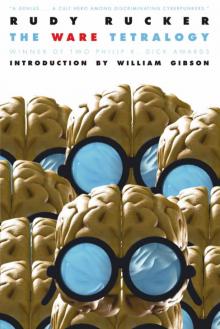 The Ware Tetralogy
The Ware Tetralogy Frek and the Elixir
Frek and the Elixir Junk DNA
Junk DNA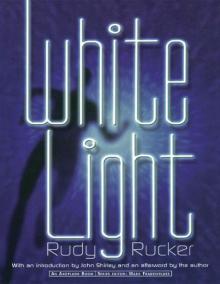 White Light (Axoplasm Books)
White Light (Axoplasm Books) Nested Scrolls
Nested Scrolls Inside Out
Inside Out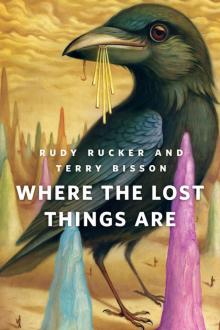 Where the Lost Things Are
Where the Lost Things Are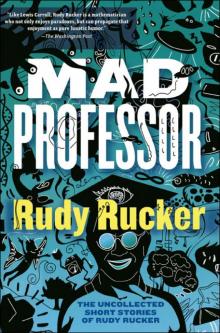 Mad Professor
Mad Professor As Above, So Below
As Above, So Below Realware
Realware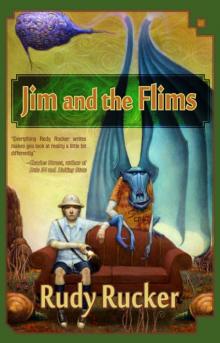 Jim and the Flims
Jim and the Flims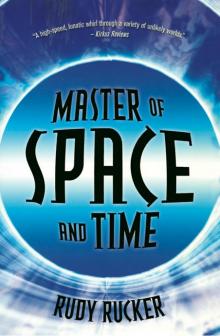 Master of Space and Time
Master of Space and Time The Big Aha
The Big Aha Hylozoic
Hylozoic